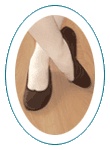Dance Kaleidoscope Costume - Regency Gentlemen
By Iain MacPhail
I get a lot of enjoyment from researching costume. Not just what people wore, but what they thought about it. How we dress is as distinctive as how we talk. It makes a statement that speaks of our class, income, sexuality, and even politics. This document is a collection of what I've found concerning English men's costume during the Regency, and it reflects my personal bias as to how I should like to be seen.
Regency Gentlemen's Clothing
It can be an expensive business kitting yourself out in the full Regency clobber, so it's worthwhile for that reason alone to get it right. Here, for what it's worth, are my recommendations. We often dance summer heat; if you are having an outfit made, I recommend that you go for light weight. When you have decided on a look, shop the op shops for stuff that might be altered.
Choose a model
Select a contemporary portrait and try to be that person. Check your sources to make sure that your model is authentic.
Uniforms
I reckon it's a pity that no-one in our group has chosen to dress in military uniform. Army uniforms were bizarre and as flash as you like. Apparently naval uniform would be unauthentic as officers were forbidden to wear uniform away from the ship. Or perhaps dress as a C of E parson.
Jacket
There are only a few styles from this period that are suitable for dancing. Check the images in this collection. Again, either have a jacket made or borrow one. I made my double-breasted navy wool jacket from an old Qantas flight crew box coat. It was too large in the chest and had several moth holes, but the fit across the shoulders and the fabric was really good. A great place to start, and if I stuffed it up, it hadn't cost much. I can't stress too highly the importance of good fit across the shoulders and chest. The sleeves should show an inch of shirt cuff (see 'The Shirt' below). Sheree knows which commercial patterns work. One style has an upstanding collar which must be stiffened to perform correctly. (The Scarlet Pimpernel kept his skeleton keys in his high jacket collar.) I recommend a good, heavy interlining or even boning. If you have a jacket like this, you can get a good, dark, iron-on material that can be cut to shape and ironed on the underside. Problem solved.
Pants
Buy or borrow suitable pants. Drop-front trousers or breeches are acceptable (the single opening fly front came in after the Regency). They should be worn high at the waist, without causing a wedgie. I strongly recommend wearing braces, allowing a little more ease in the waistband. The trouser leg length should be adjusted so that the bottom edge is at the ankle, well clear of the foot, or sitting down on the foot with a strap under the instep of the foot. There should be no turn up or cuff. Iron the pants flat, with no creases. (Creases and cuffs came later in the century, cuffs from a style-setter who rolled his trouser bottoms up out of the muck of the street, and creases came from the military as the results of stowing clothing in baggage. The bell-bottom pants of naval ratings even affected horizontal creases, and you can these days see vertical creases in US military shirts). The back lacing should firm the pants over your hips in front. Most of the preceding applies to breeches, except of course that they are fitted to just below the knee. Breeches should be worn with fine stockings. (Modern white or black long golf socks are suitable, or dance tights.)
The Shirt
 While a reproduction period shirt is best; here is a pattern of a simple work shirt;
you can get by with a carefully chosen plain white modern shirt. Shirts have just
gone through a fashion change from wide to slim fitting. Regency shirts were wide,
so try shopping in Vinnies for the wider style. You'll be wearing it with the collar up,
so try to pick one with wide collar points, rather than long ones. The collar should be
tall enough at the sides to cover the jaw, but the points should sit either side of your chin,
not jut out in front. If you leave the top button undone (your neck will be covered
by the neckcloth) it may work better. Avoid French cuffs (the ones that are turned back,
with cufflinks), but try and have the sleeves long enough so that the cuff reaches
the base of the thumb. A pleated-front formal shirt will work well if your vest is
open in front. If the shirt has a pocket, remove it.
While a reproduction period shirt is best; here is a pattern of a simple work shirt;
you can get by with a carefully chosen plain white modern shirt. Shirts have just
gone through a fashion change from wide to slim fitting. Regency shirts were wide,
so try shopping in Vinnies for the wider style. You'll be wearing it with the collar up,
so try to pick one with wide collar points, rather than long ones. The collar should be
tall enough at the sides to cover the jaw, but the points should sit either side of your chin,
not jut out in front. If you leave the top button undone (your neck will be covered
by the neckcloth) it may work better. Avoid French cuffs (the ones that are turned back,
with cufflinks), but try and have the sleeves long enough so that the cuff reaches
the base of the thumb. A pleated-front formal shirt will work well if your vest is
open in front. If the shirt has a pocket, remove it.
Neckcloth
The trick is to get it long enough. The lightest cotton lawn, will be inexpensive, and a couple of metres will make a few neckcloths. Otherwise, see the 'Neckcloths' section.
Socks
White ankle socks, preferably fine material (rather than 'sport' socks).
Shoes
 Close fitting slip-on shoes with a low vamp and a bow, like these 'court shoes',
were worn for dancing. Good hunting!
Close fitting slip-on shoes with a low vamp and a bow, like these 'court shoes',
were worn for dancing. Good hunting!
 The nearest that I've been able to find are ballet shoes. You can add a heel, if you wish,
and a flat ribbon bow like the illustration above.
The nearest that I've been able to find are ballet shoes. You can add a heel, if you wish,
and a flat ribbon bow like the illustration above.
As one who tripped over his winklepickers as a fifteen-year-old, let me say that modern ski snoot shoes look even weirder with a Regency costume. You might as well wear sneakers...
Boots
The heroes in the BBC costume dramas stride around in top boots, those black boots with the brown tops. While they look great, they are not really suitable for dancing, except perhaps for impromptu outdoors occasion. There's a sketch by one of the literary sisters (I can't remember which one) of their father dressed to visit a neighbour in coat and top boots, with his dancing shoes stuffed into a coat pocket. See the section on 'Gentlemen's Boots'.
Waistcoat
The bottom edge of waistcoats in this period are cut straight across and sit just above the front falls of the pants. This meeting of pants and waistcoat should never be allowed to gap. If you find that you tend to show your shirtfront, either use safety pins or hooks and eyes to secure pants to waistcoat. The collar is worn up, covering the neckcloth at the back. The front of the waistcoats seem all to have buttons up to the high collar in front, with the top buttons left undone to show the 'linen'. Later, the waistcoat front was cut lower with reveres.
Gloves
White gloves were worn in the evening, leather in the morning. Cheap, plain white gloves can found with cleaning supplies.
Hair
Should you have some, cultivate a casual, windswept look with long sideburns. Comb the hair forwards, without obscuring your fine, high, brow. A 'quiff' à la early Elvis will not, however, be amiss.
Facial hair
 Sideburns only! The upper lip and jaw line should be unencumbered. I have not been
selective in not showing portraits from this period of men with beards or moustaches;
I have found none. One reference of 1824 ridicules those men who are so ill-bred as to
not only wear a moustache, but to smoke in public; the combination leading to facial
conflagrations. If you are really averse to shaving, as I am, you might consider
trimming your beard very short.
Sideburns only! The upper lip and jaw line should be unencumbered. I have not been
selective in not showing portraits from this period of men with beards or moustaches;
I have found none. One reference of 1824 ridicules those men who are so ill-bred as to
not only wear a moustache, but to smoke in public; the combination leading to facial
conflagrations. If you are really averse to shaving, as I am, you might consider
trimming your beard very short.
Glasses
Spectacles were just coming into fashion at this time. There are a couple of images in this collection showing what they looked like. (I'm particularly taken by the cool dude with the blue lenses.) You can see that they have really tiny lenses, no nose pads, and the arms have loops at the ends so that they can be tied on. As with footwear and hair, modern style glasses will kill all the effort that you've put into authenticity in other parts of your costume. I'm able to ditch my glasses while I'm dancing, and I've been able to buy an antique pair of reading glasses that look at least 19th century. If you must wear glasses when you dance, George Brown can make up very nice metal frames that set the right tone, and I understand that his fees are very reasonable.
Fobs
A watch was worn in a special pocket set into the right hand side of the pants waistband. To this was attached a ribbon, to the other end of which was fastened a 'fob'. While this might be any small curio, they were most commonly a large semiprecious stone engraved with the owners 'seal' (used for leaving an impression in the wax blob used for sealing letters and authenticating documents). It's the one bright thing to be seen in most of the portraits. See the section, 'Gentlemen's Fobs'.
Jewellery
The portraits show very little if any jewellery, except for the fob and in one case a very plain pin fastening a neckcloth.
Other flash bits
Some of the portraits show the men wearing 'orders'. These were star-shaped brooches and accompanying sashes (the sash worn under the open jacket) that were displayed at court. Why not...?
Boots
Affordable vinyl riding boots are available that can be modified into reasonable facsimiles of the types of high boots worn outdoors.
Stick
Brass headed walking headed sticks are available for $20 to $50, but I find them a bit short for Regency style. A stick should reach up to your elbow and have a knob, rather than a hook.
Hat
Sheree was able to acquire a number of perfectly styled top hats. Other styles were worn, but it's a very individual choice. There is an etiquette associated with hats. On meeting a fellow gentleman one might momentarily grasp the brim in front (the origin of the military salute). On meeting a lady, the hat was removed completely (taking care to keep the inside facing your body, as it might be soiled). Hats should not be worn indoors. Do you really need to get one? No. But when you see the effect you might change your mind.
